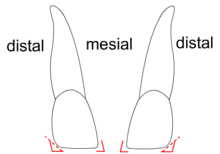Angular feature
The angle feature of the tooth is a distinguishing feature for determining whether a tooth belongs to the right or left half of the jaw .
The chewing surface or incisal edge merges mesially at a more acute angle to the approximal surface than distally .
In the case of incisors, for example, the angle between the incisal edge and the mesial side surface is more acute than between the incisal edge and the distal side surface of the crown.
The distal corner of the crown is also more rounded than the mesial.
The angular feature is most pronounced in the upper incisors.
For the aesthetic design of the tooth shape in anterior crowns, the angle feature must be taken into account.
Further identification features for the side membership of a tooth are:
In order to assign posterior teeth to the upper or lower jaw, one can also orientate oneself on the alignment of the crown .
See also
Individual evidence
- ^ Wolfgang Gühring, Joachim Barth: Anatomy: Special biology of the masticatory system . Verlag Neuer Merkur GmbH, 1992, ISBN 978-3-921280-84-3 , p. 176 ( google.com ).

